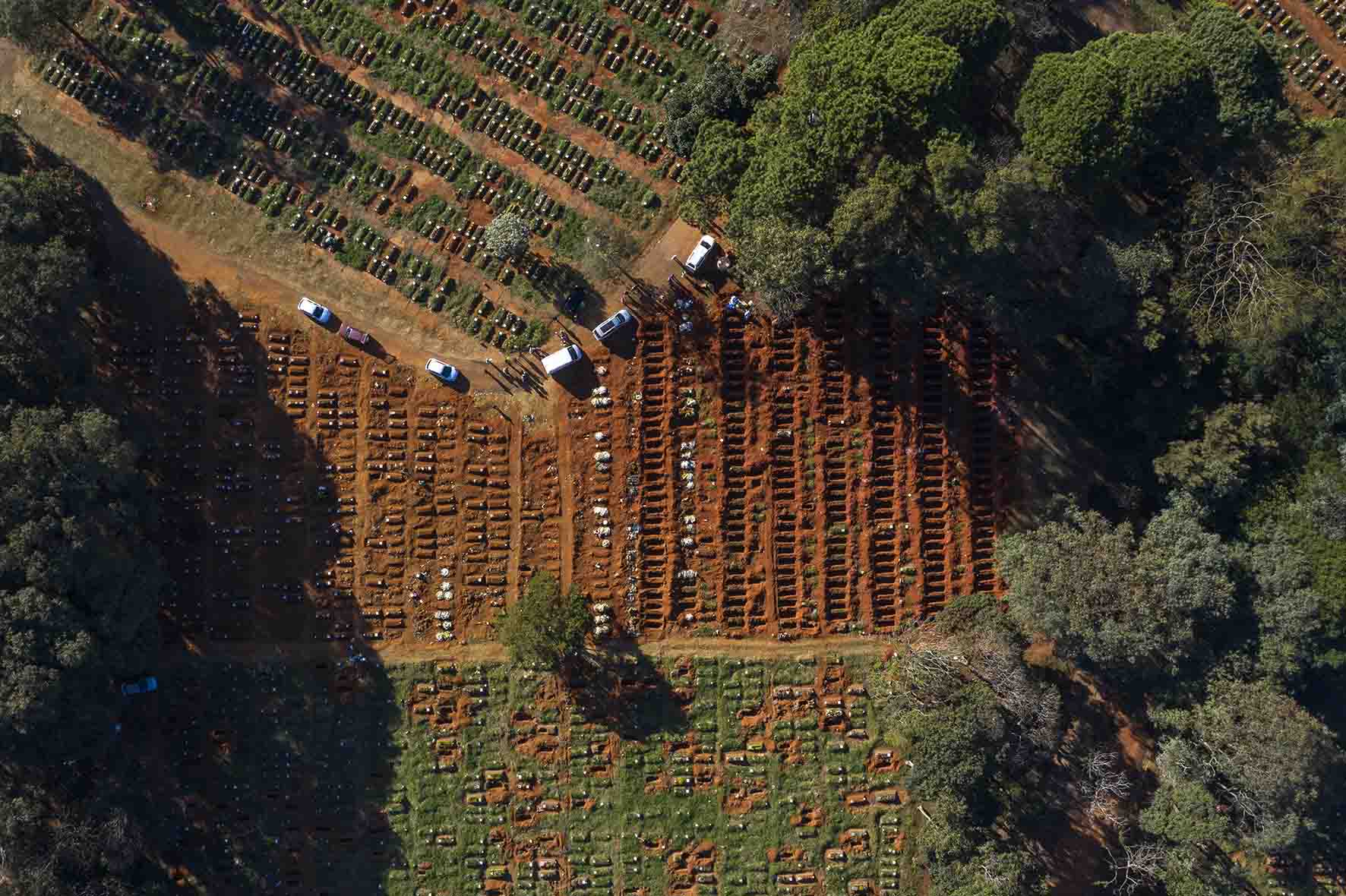Latin America’s largest cemetery makes apparent the stark reality of the far-right president’s pandemic politics
On the screen of Leonardo Finotti’s control pad the graves captured by his drone camera seem to go on forever. We are standing on a scrubby patch of grass that acts as the car park for the Cemitério da Vila Formosa, on the eastern periphery of São Paulo, about an hour from the centre of the city. This is, as evidenced by the footage gliding past, the largest burial site in Latin America. Finotti, who before the pandemic worked primarily as an architectural photographer, flying around the world to document high-profile design projects, has been mapping the burial ground since COVID-19 hit Brazil with force a year ago. His aim, he says, is to build up a comprehensive map – in which the images will overlay each other and be published in book form – of a geography in flux. More immediately the pictures form an online exhibition. Through this portrait, one that encompasses both space and time but is shot at a distance so as not to feel mawkish or intrusive, the horrific human cost of the pandemic is made clear, however jaded the viewer may have become.
At the time of writing, it’s hard to imagine how the public-health situation in Brazil could get worse: the country is experiencing a seven day average of over 3,000 COVID-19 deaths per day, of which São Paulo state accounts for a quarter; this week Brazil slipped past 360,000 deaths since the onset of the pandemic. And yet all predictions are that it will get worse. The hospitals are in a state of collapse, even in the country’s richest city; ICU capacity is at 90 percent in the majority of states. Finotti’s recent images – aerial shots in which neat grids of the dead laid to rest sit at odds with the chaotic urban sprawl visible beyond the cemetery’s border – demonstrate a surge in activity when examined side-by-side with earlier photographs he took of the same site. The photographer, working with architect Michelle Jean de Castro, has come here at least once a week over the past year, often more frequently, and as work continues to exhume old graves (the bones are removed to an elegant ossuary or to one of four ‘overflow’ shipping containers parked next to it), the newly dug holes are never vacant for long. The landscape shown in Finotti’s pictures has got progressively less green as established graves are cleared, the cemetery’s 78 hectares turning brown with freshly turned earth. As the death rate soars, the topography changes.
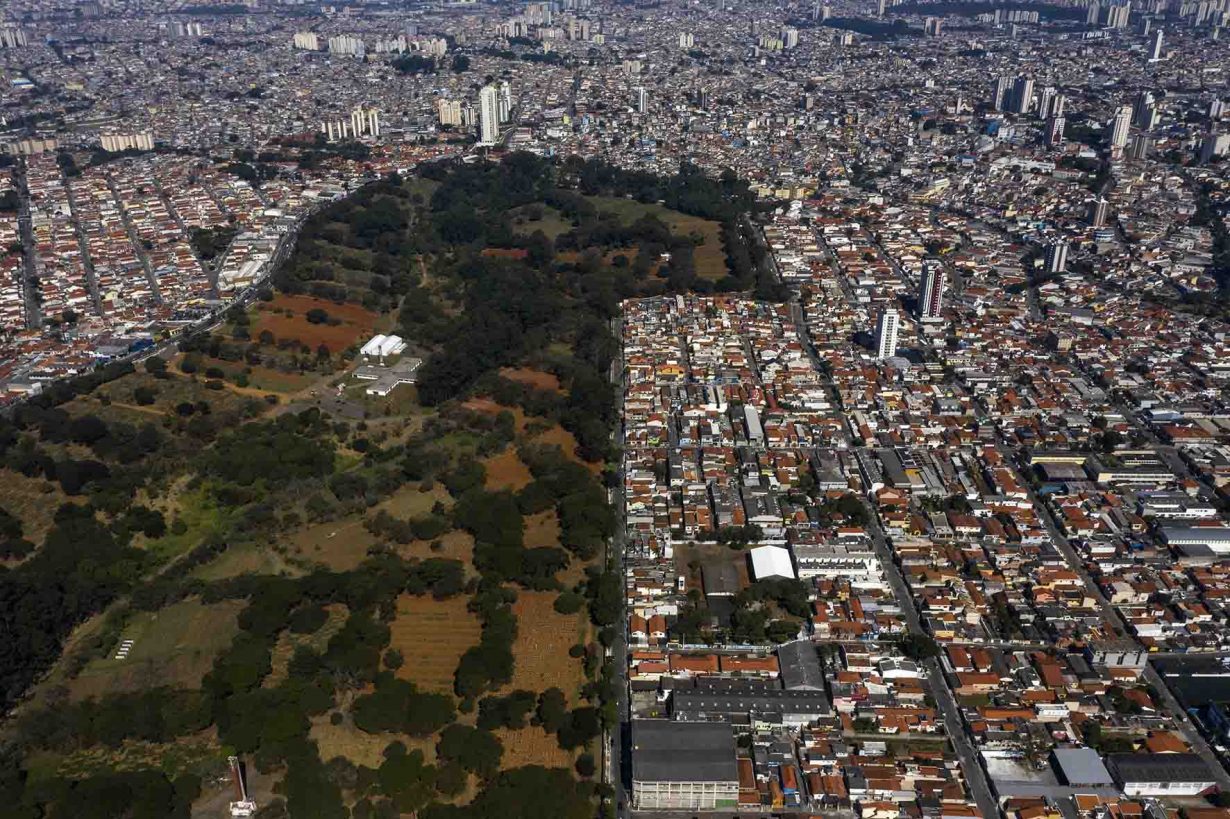
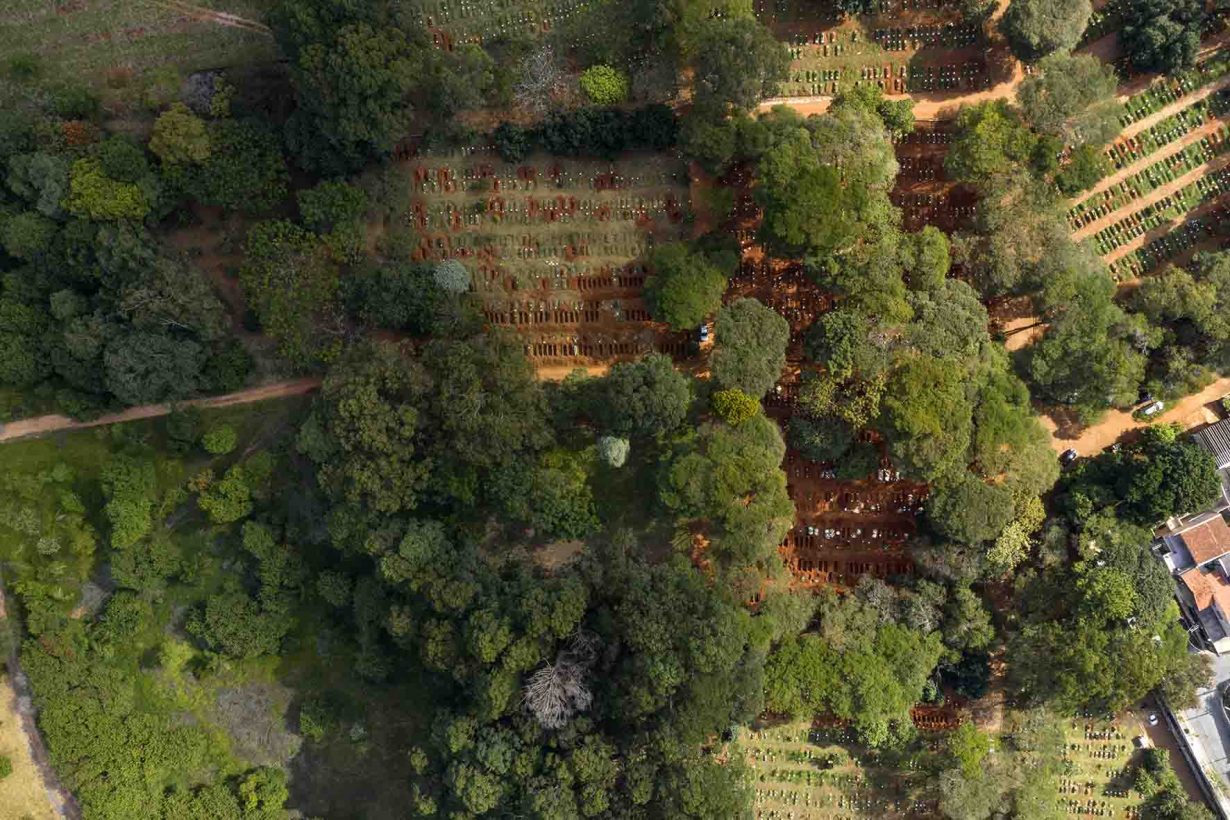
In acknowledgement of Achille Mbembe’s 2003 essay ‘Necropolitics’, Finotti has titled his project Necropoli[s]tics. Mbembe’s text is increasingly referenced in Brazil, and far beyond the circles of those who might previously have been interested in the Cameroonian philosopher’s work. His claim, that the necropolitical state is one that has jurisdiction over individual life and death, has been used by journalists and writers in mainstream newspapers and journals as they struggle to comprehend the enormity of Brazil’s ‘new’ normal.
Various countries around the world have fared better or worse in their response to COVID-19, and many avoidable deaths have occurred globally due to political incompetence or an imbalance between economic and social concerns. In Brazil, however, a far darker narrative is emerging, with increasing evidence – which is used as the basis for legal cases being brought to the International Criminal Court in The Hague – that the country’s far-right president’s actions constitute something worse than negligence. Jair Bolsonaro’s dismissal of the virus, his promotion of quack remedies and his initial rejection of vaccines surely qualify as crimes, for having, in the language of the Brazilian constitution, put ‘the life or health of others to direct and imminent danger’. This week, Luiz Inácio Lula da Silva, the former president and now likely contender in the 2022 race, claimed Bolsonaro had, last year, turned down 700 million vaccines from eight separate manufacturers. And Bolsonaro’s efforts to end or undermine lockdowns – instituted only in extremis by state governors, and nowhere nearly as restrictively as in most other countries – is clearly a case, again set out as criminal by the constitution, of ‘violating determination of public authorities, to prevent introduction or spread of contagious disease’.
Instead, the president appears to relish what Mbembe describes as ‘dividing people into those who must live and those who must die. Operating on the basis of a split between the living and the dead.’ Dimas Covas, head of Butantan, the São Paulo medical institution producing Brazil’s CoronaVac vaccine, was making the same point when he stated recently: ‘The president is practising social Darwinism. [He] exposes people to the virus: the strong survive and the rest die.’ In reality, under Bolsonaro, strength isn’t just measured in terms of physical health, but of economic viability: the well-off work from the relative safety of home, while the 40 percent of the workforce that is part of the informal economy or lower-paid retail and hospitality industries must crowd onto the streets to earn hand-to-mouth wages. With little in the way of emergency economic aid coming from the government (an initial limited scheme, made more generous by Congress, ran its course in December, and a new one is only now coming into effect), these workers are vulnerable to a bolsonarismo politics that operates in lockstep with neoliberalism to extend the colonial practice of building economies through mass exploitation and slavery, however subtle their forms.
Finotti brings his drone back to rest and packs it away. Together we head into the cemetery on foot. In the distance a small group has gathered around a grave to say final farewells, while gravediggers dressed in disposable overalls continue their work nearby, the space between the holes diminishing as the grid expands. In the leadup to the 2014 World Cup, Finotti produced a far most optimistic series of photographs, also taken from the air, of favela football pitches, rare open spaces that contrasted with the tightly packed ad hoc housing surrounding them. There is a cruel irony in considering these two projects side-by-side, the environmental density forced on the living now replicated in the spaces reserved for the dead. Municipal authorities say 30 additional gravediggers have been employed at the site in the last year.
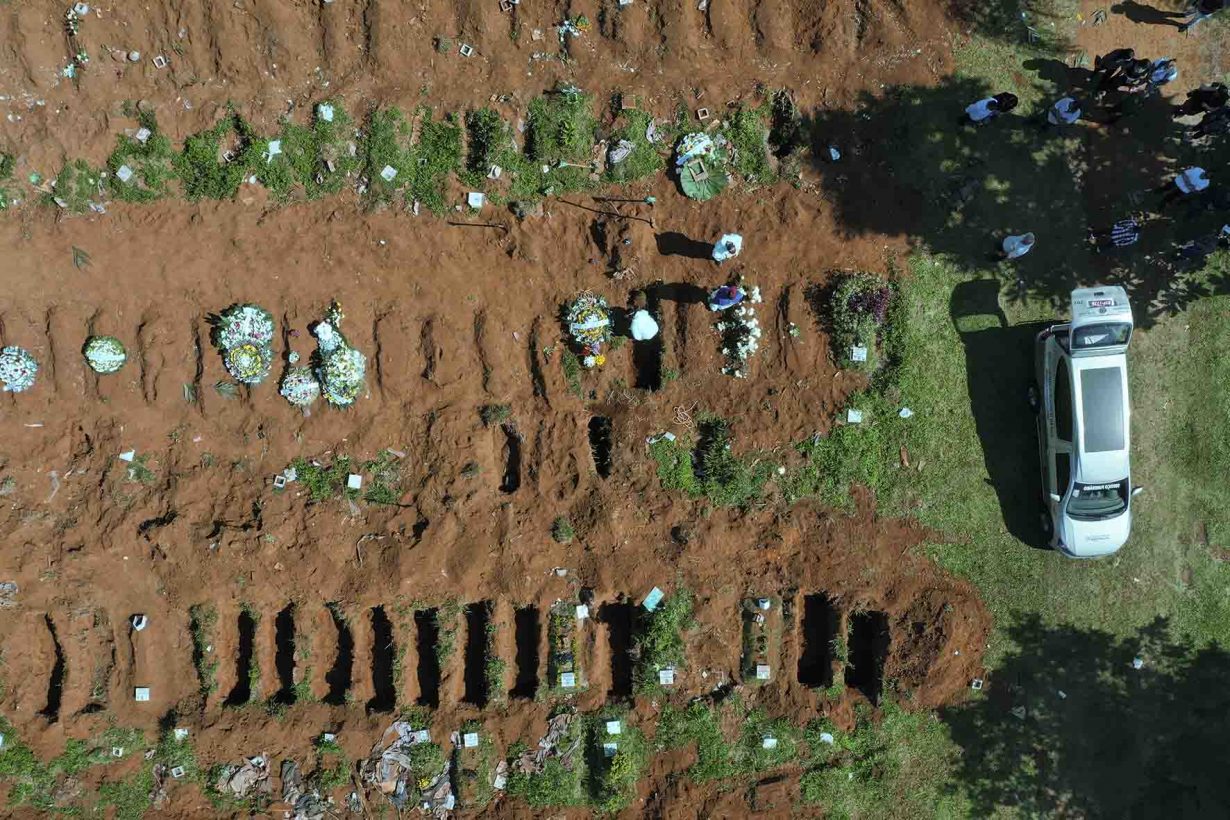
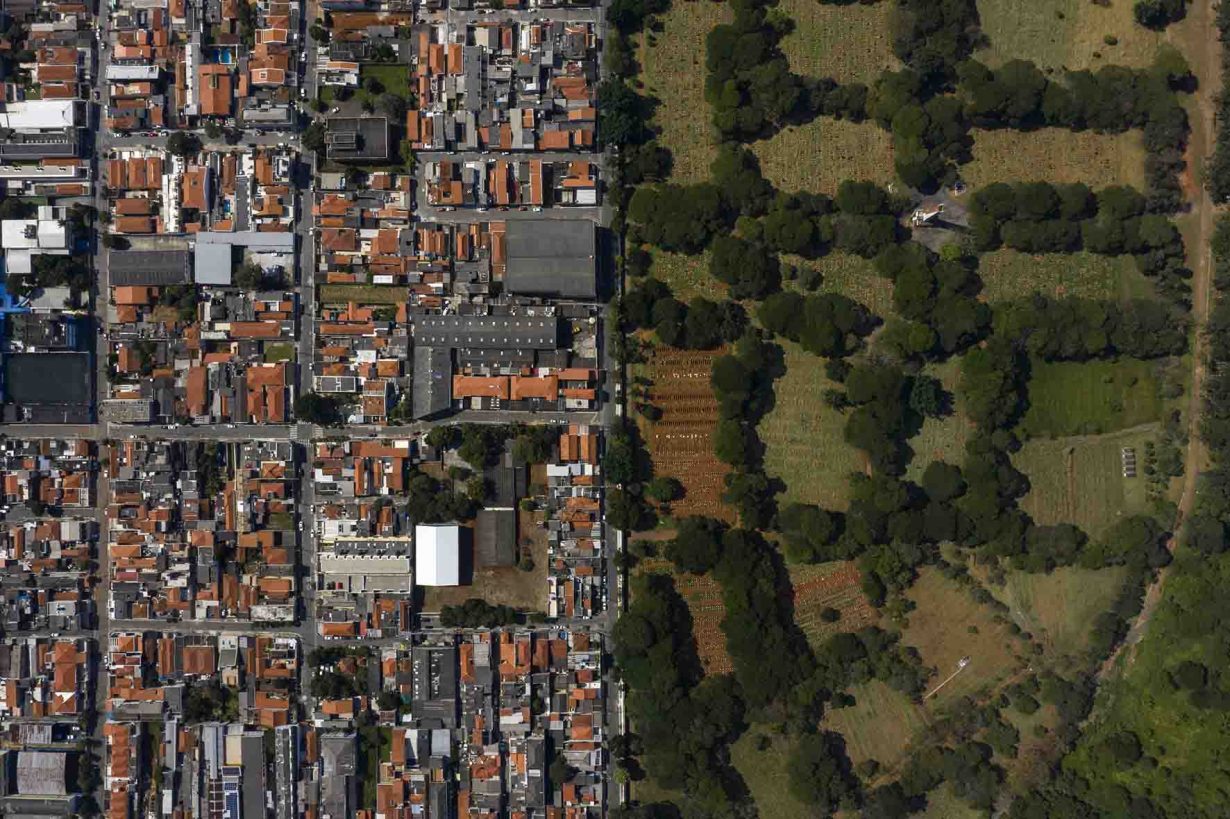
Behind every crime is a motive. Bolsonaro’s rationale goes further than a simple calculation that preventing an economic downturn is worth the loss of life (though Uruguayan writer Eduardo Galeano’s poem about the ‘nobodies’ who ‘are not human beings, but human resources… who are not worth the bullet that kills them’ is instructive to this way of thinking). Instead, it is another part of Mbembe’s text that provides the answer to what is going on. Under necropolitics, the philosopher argues, the state initiates a ‘war without end’.
Conflict has been the bolsonarismo strategy from the beginning. The president, a former army captain after all, knows no other way by which to keep his political stock high. In the early days of his rule, combat came from fomenting a furious culture war between his supporters and detractors in which the arts often became the target: plays and exhibitions were closed down, and mobs whipped up by the president’s rhetoric forced artists and actors into hiding. At other times the targets have been gay and trans communities; women; seemingly randomly picked international foes such as China. Now his battle is with the medical establishment, scientists and state governors who beg for a positive pandemic strategy. These latter wars have victims beyond the odd cancelled exhibition or play, and it’s a modus operandi he’s never hidden. As far back as 1999, when, as a little-known federal deputy for Rio de Janeiro, he made an appearance on a talkshow, he announced, “You won’t change anything in this country through voting – nothing, absolutely nothing. Unfortunately, you’ll only change things by having a civil war, and doing the job that the military regime did not do. By killing about 30,000… If a few innocent people die, that’s alright.” By June last year Bolsonaro had hit his target.
The leader’s support is slipping (in recent weeks he’s lost his defence minister and three heads of the armed forces, all of whom resigned after publicly affirming loyalty to the constitution rather than to Bolsonaro personally), and if it was measured according to the volume and frequency of pot-bashing protests that take place throughout the county, one might say he was done for. The reverberations of wood spoon against iron that bounce off the concrete blocks of my downtown neighbourhood are now joined by cries of “Genicida!” Yet for many Bolsonaro represents strength, the embodiment of machismo, a figure not frightened by a ‘little flu’. A day after joining Finotti in the cemetery, I pass the Museu de Arte de São Paulo, in the centre of the city, where a crowd of the president’s diehard supporters have gathered under the building’s pillars (a popular protest spot), their banners criticising the statewide lockdown. The museum is closed, part of the local measures condemned by the president, but somewhere inside hangs a painting from 1966 titled O Heroi (The Hero), by Anna Maria Maiolino. It shows a grinning skeleton dressed in a heavily decorated military uniform, a symbol of Brazil’s dictatorship years. Its sunken eyes recall the current president: a hero to those demonstrating below, his heroism built on the graves of Vila Formosa.
